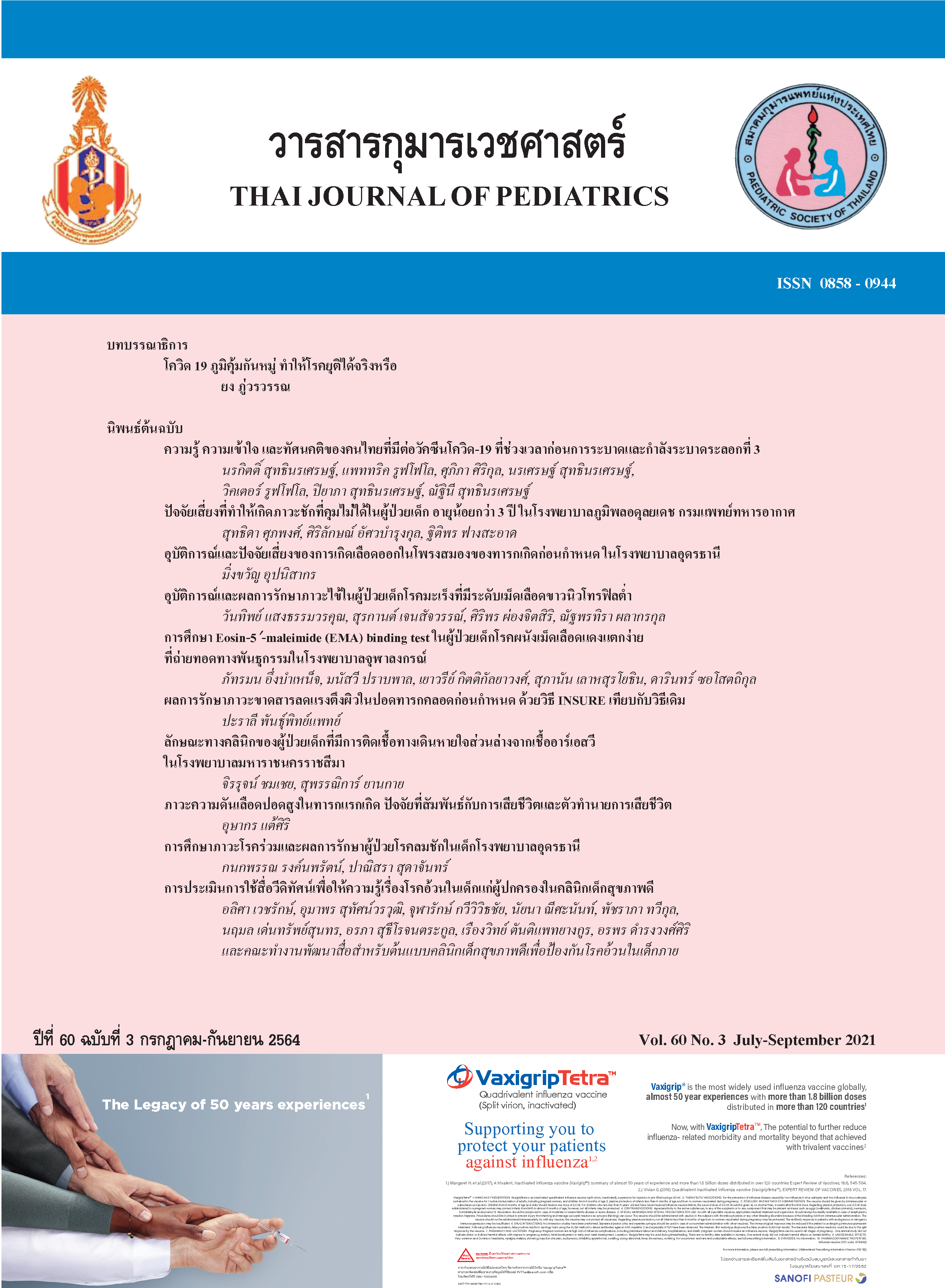การศึกษา Eosin-5′-maleimide (EMA) binding test ในผู้ป่วยเด็กโรคผนังเม็ดเลือดแดงแตกง่าย ที่ถ่ายทอดทางพันธุกรรมในโรงพยาบาลจุฬาลงกรณ์
คำสำคัญ:
Hereditary red blood cell membrane defect, hereditary spherocytosis, Eosin-5′-maleimide binding testบทคัดย่อ
ความเป็นมา : กลุ่มโรคผนังเม็คเลือดแดงแตกง่ายที่ถ่ายทอดทางพันธุกรรม (hereditary red blood cell membrane defect) เป็นโรคที่มีความผิดปกติทางพันธุกรรมก่อให้เกิดความผิดปกติของโครงสร้างผนังเม็ดเลือดแดง ทำให้เม็ดเลือดแดงมีรูปร่างที่ผิดปกติและแตกง่าย โรคที่พบบ่อยในกลุ่มนี้ ได้แก่
hereditary spherocytosis (HS), southeast asian ovalocytosis (SAO), hereditary elliptocytosis (HE) และ hereditary pyropoikilocytosis (HPP) การตรวจทางห้องปฏิบัติการเพื่อวินิจฉัยโรคกลุ่มนี้คือ osmotic fragility test (OFT) แต่เป็นวิธีที่มีความความไว้ในการวินิฉัยที่จำกัด และใช้ระยะเวลาในการตรวจนาน ดังนั้นจึงได้ศึกษาการตรวจด้วยวิธีใหม่คือ Eosin-5-maleimide (EMA) binding test เพื่อเพิ่มประสิทธิภาพและลดระยะเวลาในการตรวจวินิจฉัยให้ถูกต้องและรวดเร็ว
วิธีการศึกษา : ศึกษาการตรวจทางห้องปฏิบัติการด้วยวิธี EMA binding (est ในผู้ป่วยที่ได้รับการวินิจฉัยเป็น hereditary red blood cell membrane defect ทุกราย รวม 14 ราย (กลุ่มผู้ป่วย Hร า ราย กลุ่มผู้ป่วย SAO 4 ราย กลุ่มผู้ป่วย HE 3 ราย) กลุ่มผู้ป่วยที่มีภาวะโลหิตจางจากการแตกของเม็ดเลือด แดงอื่นๆ (other hemolytic anemias) จำนวน 39 ราย และกลุ่มคนปกติ (normal control) จำนวน 93 ราย
ผลการศึกษา : ผลการตรวจ EMA binding test พบว่ากลุ่มผู้ป่วย HS ได้ค่า % ของ Mean Fluorescence Intensity (MFI) = 68.08 (SD 8.54) กลุ่มผู้ป่วย SAO ได้ก่ %MFI = 65.38 (SD 5.21) กลุ่มผู้ป่วย HE ได้คำ %MFI = 89.36 (SD 5.ร7) กลุ่มผู้ป่วย hemolyic ancmia อื่นๆ ได้ค่า %MFI = 96.10 (SD 6.94) กลุ่ม normal control ได้ค่ %MF! = 100.33 (SD 5.55) ตามลำคับ เมื่อทำการเปรียบเทียบกลุ่มผู้ป่วย HS และ SAO แตกต่างกับกลุ่ม normal contro! และกลุ่มผู้ป่วย hemolyic ancmia อื่นๆ และกลุ่มผู้ป่วย HE อย่างมี นัยสำคัญทางสถิติ (P< .001) ตามลำดับ
สรุปผลการศึกษา : การตรวจด้วยวิธี EMA binding test สามารถแยกกลุ่มผู้ป่วย HS และกลุ่มผู้ป่วย SAO ออกจากกลุ่มผู้ป่วย hemolyic anemia อื่นๆ และกลุ่มผู้ป่วย HE ได้อย่างชัดเจน ดังนั้นจึงเป็นวิธีที่มีความเหมาะสมที่จะนำมาใช้สำหรับวินิจฉัยผู้ป่วย HS และ SAO
Downloads
เอกสารอ้างอิง
Mohandas N, Evans E. Mechanical properties of the red cell membrane in relation to molecular structure and genetic defects. Annu Rev Biophys Biomol Struct. 1994; 23: 787-818.
Perrotta S, Gallagher PG, Mohandas N: Hereditary spherocytosis. Lancet 2008; 372: 1411–1426.
Bolton-Maggs PH, Langer JC, Iolascon A, Tittensor P, King MJ. General Haematology Task Force of the British Committee for Standards in Haematology: Guidelines for the diagnosis and management of hereditary spherocytosis – 2011 update. Br J Haematol 2012; 156: 37–49.
Perrotta S, Gallagher PG, Mohandas N. Hereditary spherocytosis. The Lancet. 2008; 372 (9647):1411-1426.
An X, Mohandas N. Disorders of red cell membrane. Br J Haematol 2008; 141:367-75.
Narla J, Mohandas N. Red cell membrane disorders. Int J Lab Hematol 2017;39 Suppl1:47-52.
Bolton-Maggs PH, Stevens RF, Dodd NJ, Lamont G, Tittensor P, King MJ. Guidelines for the diagnosis and management of hereditary spherocytosis. Br J Haematol 2004; 126:455-74.
R D Arora , J Dass , S Maydeo , V Arya , N Radhakrishnan , A Sachdeva , J Kotwal , M Bhargava. Flow cytometric osmotic fragility test and eosin-5’-maleimide dye-binding tests are better than conventional osmotic fragility tests for the diagnosis of hereditary spherocytosis. Int J Lab Hematol. Int J Lab Hematol 2018 Jun; 40(3):335-342.
Sang Hyuk Park , Chan-Jeoung Park, Bo-Ra Lee , et all. Comparison study of the eosin-5’-maleimide binding test, flow cytometric osmotic fragility test, and cryohemolysis test in the diagnosis of hereditary spherocytosis. Am J Clin Pathol 2014 Oct; 142(4):474-84
ดาวน์โหลด
เผยแพร่แล้ว
รูปแบบการอ้างอิง
ฉบับ
ประเภทบทความ
สัญญาอนุญาต

อนุญาตภายใต้เงื่อนไข Creative Commons Attribution-NonCommercial-NoDerivatives 4.0 International License.



